Massimo Tornatore
Vertical Federated Learning for Failure-Cause Identification in Disaggregated Microwave Networks
Feb 05, 2025Abstract:Machine Learning (ML) has proven to be a promising solution to provide novel scalable and efficient fault management solutions in modern 5G-and-beyond communication networks. In the context of microwave networks, ML-based solutions have received significant attention. However, current solutions can only be applied to monolithic scenarios in which a single entity (e.g., an operator) manages the entire network. As current network architectures move towards disaggregated communication platforms in which multiple operators and vendors collaborate to achieve cost-efficient and reliable network management, new ML-based approaches for fault management must tackle the challenges of sharing business-critical information due to potential conflicts of interest. In this study, we explore the application of Federated Learning in disaggregated microwave networks for failure-cause identification using a real microwave hardware failure dataset. In particular, we investigate the application of two Vertical Federated Learning (VFL), namely using Split Neural Networks (SplitNNs) and Federated Learning based on Gradient Boosting Decision Trees (FedTree), on different multi-vendor deployment scenarios, and we compare them to a centralized scenario where data is managed by a single entity. Our experimental results show that VFL-based scenarios can achieve F1-Scores consistently within at most a 1% gap with respect to a centralized scenario, regardless of the deployment strategies or model types, while also ensuring minimal leakage of sensitive-data.
Maximizing Revenue with Adaptive Modulation and Multiple FECs in Flexible Optical Networks
Jun 14, 2021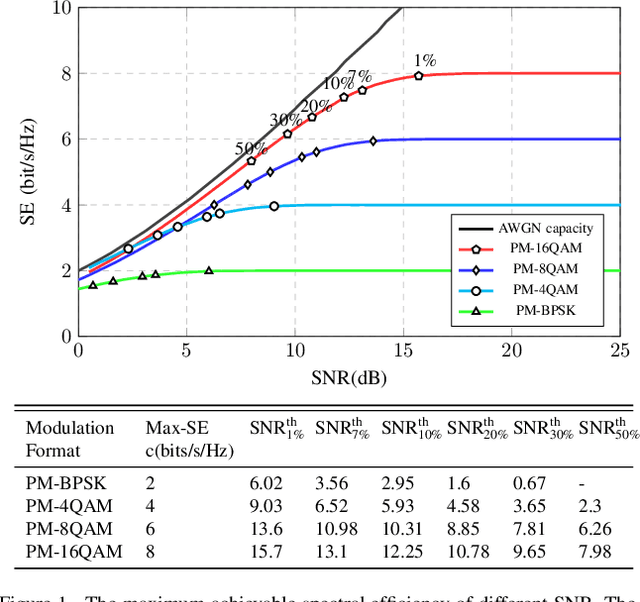
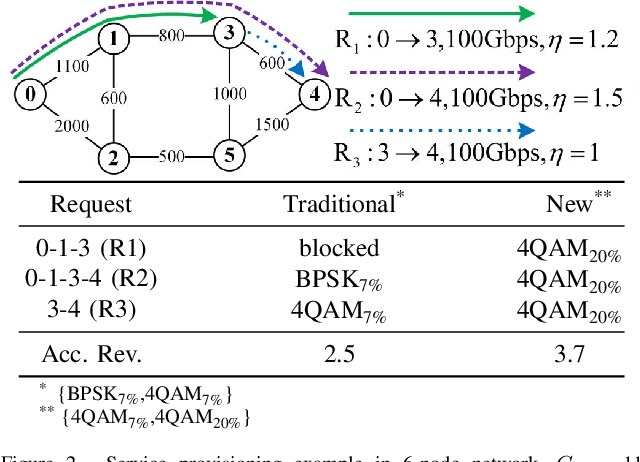


Abstract:Flexible optical networks (FONs) are being adopted to accommodate the increasingly heterogeneous traffic in today's Internet. However, in presence of high traffic load, not all offered traffic can be satisfied at all time. As carried traffic load brings revenues to operators, traffic blocking due to limited spectrum resource leads to revenue losses. In this study, given a set of traffic requests to be provisioned, we consider the problem of maximizing operator's revenue, subject to limited spectrum resource and physical layer impairments (PLIs), namely amplified spontaneous emission noise (ASE), self-channel interference (SCI), cross-channel interference (XCI), and node crosstalk. In FONs, adaptive modulation, multiple FEC, and the tuning of power spectrum density (PSD) can be effectively employed to mitigate the impact of PLIs. Hence, in our study, we propose a universal bandwidth-related impairment evaluation model based on channel bandwidth, which allows a performance analysis for different PSD, FEC and modulations. Leveraging this PLI model and a piecewise linear fitting function, we succeed to formulate the revenue maximization problem as a mixed integer linear program. Then, to solve the problem on larger network instances, a fast two-phase heuristic algorithm is also proposed, which is shown to be near-optimal for revenue maximization. Through simulations, we demonstrate that using adaptive modulation enables to significantly increase revenues in the scenario of high signal-to-noise ratio (SNR), where the revenue can even be doubled for high traffic load, while using multiple FECs is more profitable for scenarios with low SNR.
Intelligent Reflecting Surface Assisted Anti-Jamming Communications Based on Reinforcement Learning
Dec 23, 2020

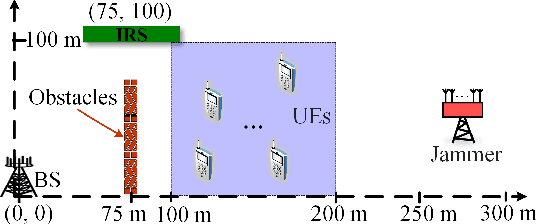

Abstract:Malicious jamming launched by smart jammer, which attacks legitimate transmissions has been regarded as one of the critical security challenges in wireless communications. Thus, this paper exploits intelligent reflecting surface (IRS) to enhance anti-jamming communication performance and mitigate jamming interference by adjusting the surface reflecting elements at the IRS. Aiming to enhance the communication performance against smart jammer, an optimization problem for jointly optimizing power allocation at the base station (BS) and reflecting beamforming at the IRS is formulated. As the jamming model and jamming behavior are dynamic and unknown, a win or learn fast policy hill-climbing (WoLF-PHC) learning approach is proposed to jointly optimize the anti-jamming power allocation and reflecting beamforming strategy without the knowledge of the jamming model. Simulation results demonstrate that the proposed anti-jamming based-learning approach can efficiently improve both the IRS-assisted system rate and transmission protection level compared with existing solutions.
A Survey on Application of Machine Learning Techniques in Optical Networks
Oct 05, 2018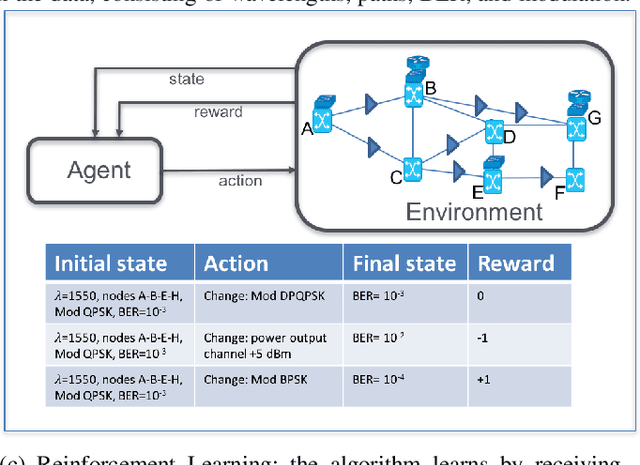
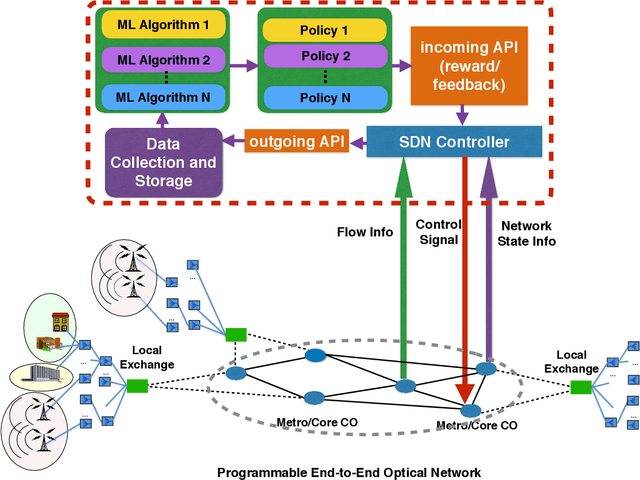
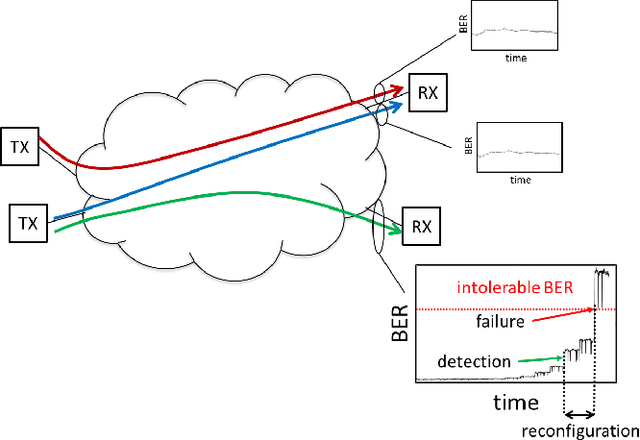
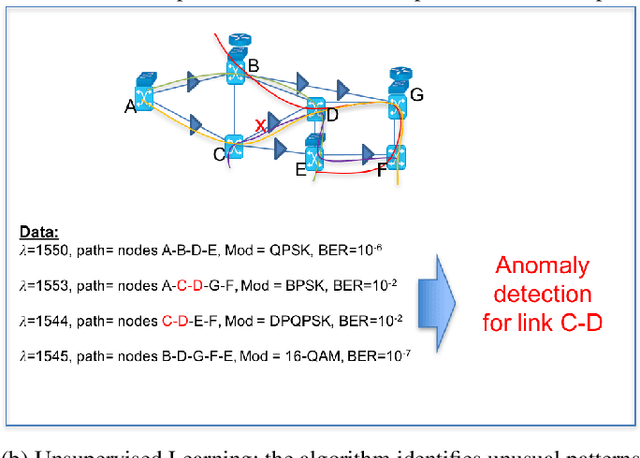
Abstract:Today's telecommunication networks have become sources of enormous amounts of widely heterogeneous data. This information can be retrieved from network traffic traces, network alarms, signal quality indicators, users' behavioral data, etc. Advanced mathematical tools are required to extract meaningful information from these data and take decisions pertaining to the proper functioning of the networks from the network-generated data. Among these mathematical tools, Machine Learning (ML) is regarded as one of the most promising methodological approaches to perform network-data analysis and enable automated network self-configuration and fault management. The adoption of ML techniques in the field of optical communication networks is motivated by the unprecedented growth of network complexity faced by optical networks in the last few years. Such complexity increase is due to the introduction of a huge number of adjustable and interdependent system parameters (e.g., routing configurations, modulation format, symbol rate, coding schemes, etc.) that are enabled by the usage of coherent transmission/reception technologies, advanced digital signal processing and compensation of nonlinear effects in optical fiber propagation. In this paper we provide an overview of the application of ML to optical communications and networking. We classify and survey relevant literature dealing with the topic, and we also provide an introductory tutorial on ML for researchers and practitioners interested in this field. Although a good number of research papers have recently appeared, the application of ML to optical networks is still in its infancy: to stimulate further work in this area, we conclude the paper proposing new possible research directions.
 Add to Chrome
Add to Chrome Add to Firefox
Add to Firefox Add to Edge
Add to Edge